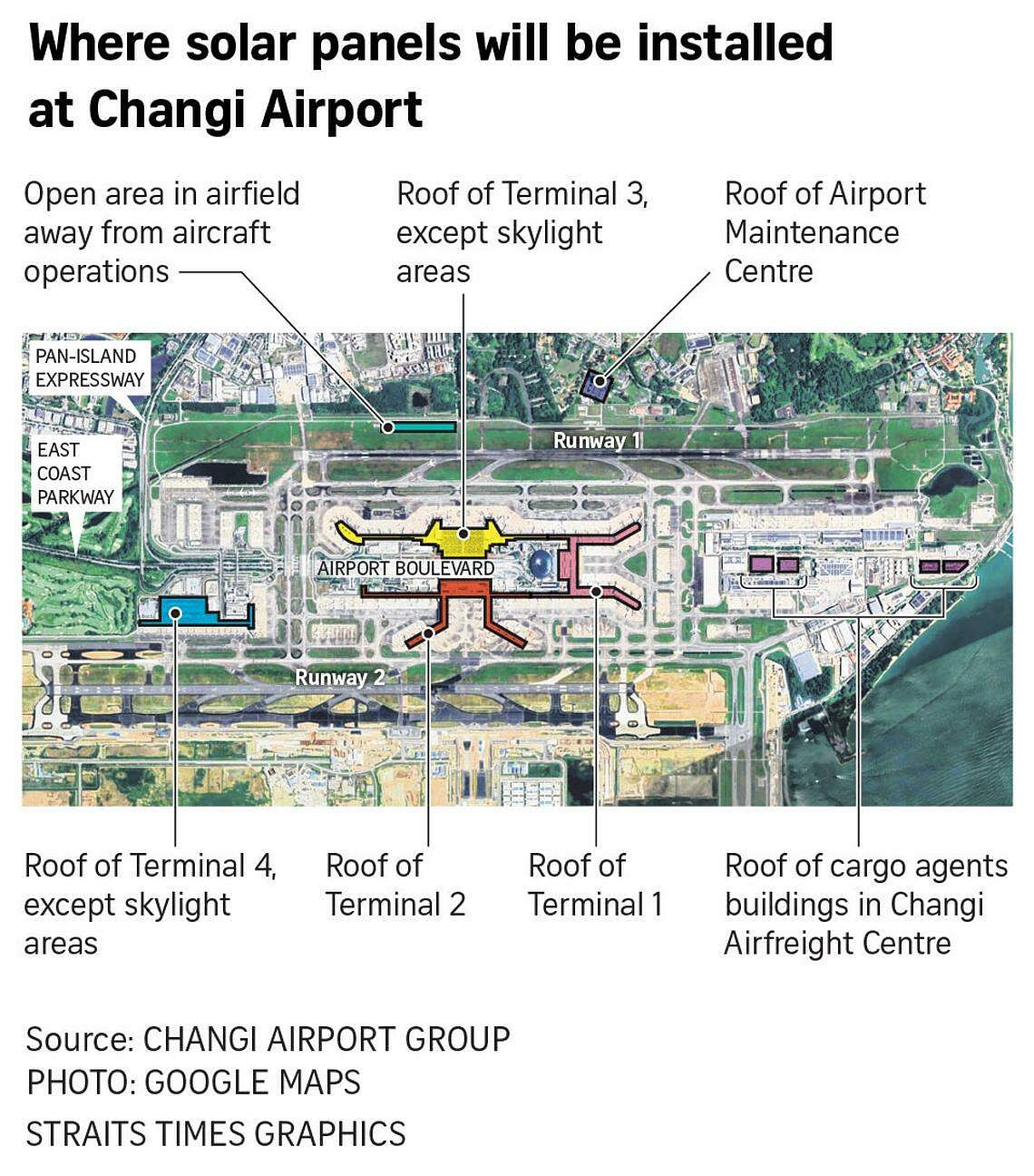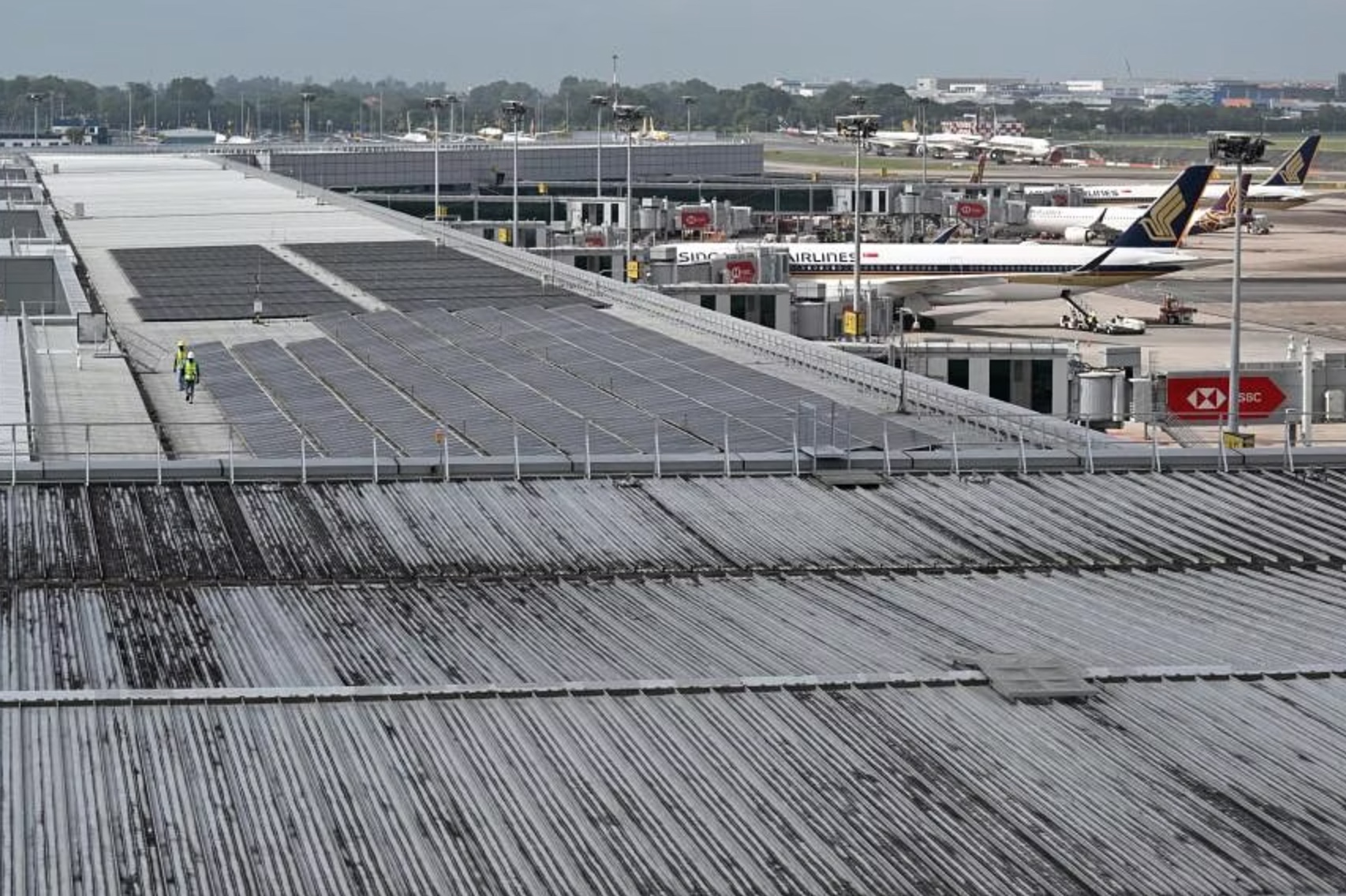SINGAPORE – Changi Airport is taking its decarbonisation efforts up a notch and has started work on the installation of a large-scale solar photovoltaic (PV) system on the roofs of passenger terminals, as well as airfield and cargo buildings operated by Changi Airport Group (CAG).
When completed in early 2025, it will be Singapore’s largest rooftop solar PV system in a single location, airport operator CAG and asset manager Keppel announced on Feb 14.
Another system will be installed at a 4ha area – the equivalent of nearly six football fields – within the airfield, away from spaces where aircraft operate.
This comes after an international panel of experts and business representatives in 2022 recommended that Changi Airport consider installing solar panels on open spaces within the airfield.
CAG said on Feb 14 that it has appointed Keppel to design, build, own and operate the solar PV systems at Changi Airport for 25 years.
Once ready, the solar PV systems will have a combined generation capacity of 43MW-peak (MWp).
Of this, 38MWp will be generated from the system installed on rooftops, while the remaining 5MWp of solar generation capacity will be from the system in the airfield.
CAG and Keppel said the new systems would reduce CAG’s carbon emissions by about 10 per cent of its energy consumption levels in 2019, or about 20,000 tonnes every year.
The systems will generate enough solar energy to power more than 10,000 four-room Housing Board flats yearly, they added.
CAG and Keppel said the installation of solar PV systems in airports comes with unique challenges, compared with conventional installation at commercial, industrial or residential sites.
Before installation, simulation studies were done to ensure that the solar panels would be tilted optimally to maximise solar power yield, while not posing glare or glint effects to air traffic controllers and pilots operating in the vicinity of the airport, CAG said.
Glare or glint effects, which refer to the indirect reflection of light for short or long durations, could reduce air traffic controllers’ and pilots’ visibility of air traffic nearby and pose a danger to passengers’ safety.
CAG and Keppel also noted that installation and maintenance processes would need to comply with aviation safety and security requirements.
CAG declined to reveal the cost of the solar PV project, citing commercial sensitivities.
The completed systems will be integrated with Keppel’s operations nerve centre at Changi, which will provide real-time reporting of solar generation metrics and advanced fault detection, to ensure that operations run smoothly.
A smaller-scale 640 kilowatt-peak solar PV system will also be installed on the roof of the airport’s maintenance and storage centre in the airport compound, cutting the facility’s carbon emissions by about half.

The Straits Times reported in September 2022 that Changi Airport has existing rooftop solar panels with a total capacity of 22MWp, or 4 per cent of its energy use before the Covid-19 pandemic.
Mr Koh Ming Sue, CAG’s executive vice-president for engineering and development, described the latest move as a “significant step forward” in the airport operator’s decarbonisation efforts.
Mr Lim Yong Wei, general manager of the infrastructure division at Keppel, said Keppel hopes to continue working with CAG to explore more decarbonisation solutions.
Beyond this project, CAG is exploring solutions for larger-scale deployment of solar energy systems in the airfield closer to areas where aircraft operate, which is part of the international advisory panel’s recommendations under the Singapore Sustainable Air Hub Blueprint.
CAG has also set a goal of net-zero emissions by 2050, and will work towards it by increasing the share of renewable energy in its energy mix.
Similar solar energy projects are being set up across the country, including on the rooftops of 1,075 HDB blocks with a solar capacity of 113MWp and a floating solar farm in Tengeh Reservoir with a 60MWp solar capacity.
Dr Thomas Reindl, deputy chief executive of the National University of Singapore’s (NUS) Solar Energy Research Institute of Singapore, noted that the solar PV systems’ solar capacity of 43MWp at Changi Airport is very sizeable, making it one of the largest solar installations in Singapore.
Given that part of the project will be installed at the airfield, which is usually governed by strict restrictions, he said CAG “went all out” to maximise the use of space.
He added that the deployment of the solar PV system on rooftops, despite the competing needs for space on rooftops, also points to the maximisation of space.
Dr David Broadstock, a senior research fellow and lead of energy transition at NUS’ Sustainable and Green Finance Institute, said the project is a significant move.
However, he added, there is a lot of potential for innovative solutions to further lessen CAG’s carbon footprint beyond the current reduction of 10 per cent of 2019’s levels.
Dr Broadstock noted that the growing demand for airport services would require more energy to be used in the future, possibly negating the total carbon savings if the growth is too large.
He said CAG could also integrate energy storage solutions to capture excess solar energy during daylight or off-peak operational periods, and deploy it in the evenings.
Looking ahead, Dr Broadstock noted that solar panels could potentially be integrated into the upcoming Terminal 5 from the design stage, offering new opportunities for building-integrated PV technologies – where solar panels form part of the building structure.
It was previously announced that Terminal 5 will be more energy-efficient and be equipped with solar panels.

